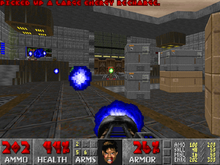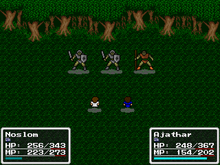A video game genre is a specific category of games related by a similar gameplay characteristic. Genres are not usually defined by the actual content of the game or its medium of play, but by its common challenge.[1]
Genres may encompass a wide variety of games, leading to even more specific classifications called subgenres. For example, an action gamecan be classified into many subgenres such as platform games andfighting games. Some games, most notably browser and mobile games, are commonly classified into multiple genres.[1][2]
The following is a list of all commonly defined video game genres, with short descriptions for individual genres and major subgenres.
Contents
[hide]Action[edit]
Main article: Action game
Action games emphasize physical challenges that require eye-hand coordination and motor skill to overcome. They center around the player, who is in control of most of the action. Most of the earliest video games were considered action games; today, it is still a vast genre covering all games that involve physical challenges.
Action games are classified by many subgenres. Platform games and fighting games are among the best-known subgenres, while shooter games became and continue to be one of the dominant genres in video gaming since the 1990s.[3][4] Action games usually involve elements of twitch gameplay.[3]
Platform games[edit]
Main article: Platform game
Platform games (or platformers) are set in a vertical or three-dimensional (3D) environment. Players guide a character through obstacles, jumping on platforms and battling enemies in order to advance. They often involve unrealistic physics and special movement abilities.[2]
Donkey Kong was one of the earliest and best-known platformers; the American gaming press classified it using the term climbing game at the time.[5] Super Mario Bros. was one of the best-selling games of all time; more than 40 million copies were sold (excluding Game Boy Advance and Virtual Console sales).[6] Jumping Flash! was the first console platformer to incorporate 3D graphics.[7]
Shooter games[edit]
Main article: Shooter game
In shooter games (or simply shooters), players use ranged weapons to participate in the action, which takes place at a distance.[2] Most shooters involve violent gameplay; lethal weaponry is used to damage opponents. However, some shooters, such as Splatoon, have non-violent objectives.
Shooters, aside from subgenre classifications, can be further classified by their perspective of play. First-person shooters are played within the protagonist's perspective; they often include a heads-up display displaying key information such as the current health of the protagonist.[8][9] In third-person shooters, the protagonist's body can be seen fully; the environment is rendered from a distance.[9]Some shooters incorporate both perspectives.[2]
Hero shooters are either multiplayer first- or third-person shooters that strongly encourage cooperative play between players on a single team through the use of pre-designed "hero" characters that each possess unique attributes, skills, weapons, and other activated abilities. While setting up a match, players on a team typically must each select a different hero than those selected by teammates, and as the match progresses, the players gains experience to unlock more powerful abilities for their hero. Outside of a match, players have the ability to customize the appearance of the heroes but with no other in-game effects. Such games are inspired by multiplayer online battle arena games like Dota 2 and League of Legends, and popular team-based shooters likeTeam Fortress 2. Examples of hero shooters include Battleborn, Overwatch, and Paladins: Champions of the Realm.[10]
Light gun shooters are controlled with a gun-shaped controller; light guns function via a light sensor, hence the name "light gun". The technology has been used as early as the 1920s for shooter games, although electronic video gaming did not exist at that time.
Shoot 'em ups pit players, who are usually shooting from a vehicle, against large waves of opponents; the player must attack and avoid opponent attacks as well as obstacles. In most shoot 'em ups, players influence the actions of a vehicle instead of the protagonist.[11]
Since the 1990s, shooters, most notably first-person shooters, have become widely successful in video gaming, accounting for a large percentage of video game sales.[12] Wolfenstein 3D, created by Id Software and released in 1992, was credited for pioneering gameplay and graphics elements incorporated by many other shooters.[13] Also developed by Id and published one year after Wolfenstein 3D's release, Doom is broadly considered to be one of the most influential games in video gaming history.[13] Other successful shooter series include Half-Life, a widely acclaimed and commercially successful series noted for its influence on contemporary shooters; and the Call of Dutyfranchise, with more than 175 million sales across all its titles.[14]
Fighting games and beat 'em ups[edit]
Main article: Fighting game
Fighting games simulate close-range combat against a few opponents, often involving violent and exaggerated unarmed attacks against opponents. While ranged and melee weapons may be present in fighting games, they emphasize hand-to-hand combat.[2] Beat 'em ups (or brawlers) are a related, but distinct genre; they both involve close-range combat, but beat 'em ups pit players against large waves of opponents as opposed to a few.[2][11] Many fighting games incorporate heavily emphasized attacks based on various martial arts systems. Fighting games were one of the dominant genres in video gaming until the late-1990s, where the genre saw a general decline. Fighting games released after the late-1990s, including ones that are part of popular franchises, did not attain the popularity of earlier fighting games.[15] Beat 'em ups saw a sudden decline in popularity in the same time period, but 3D beat 'em ups have kept the genre alive.[16]
Stealth game[edit]
Stealth games are a somewhat recent subgenre, sometimes referred to as "sneakers" or "creepers" to contrast with the action-oriented "shooter" subgenre. These games tend to emphasize subterfuge and precision strikes over the more overt mayhem of shooters, for example, the Metal Gear series and the Sly Cooper series.
Action-adventure[edit]
Main article: Action-adventure game
Action-adventure games combine elements of their two component genres, typically featuring long-term obstacles that must be overcome using a tool or item as leverage (which is collected earlier), as well as many smaller obstacles almost constantly in the way, that require elements of action games to overcome. Action-adventure games tend to focus on exploration and usually involve item gathering, simple puzzle solving, and combat. "Action-adventure" has become a label which is sometimes attached to games which do not fit neatly into another well known genre.
The first action-adventure game was the Atari 2600 game Adventure (1979). It was directly inspired by the original text adventure, Colossal Cave Adventure. In the process of adapting a text game to a console with only a joystick for control, designer Warren Robinett created a new genre. Another typical Action-Adventure game is "The Legend of Zelda" by Nintendo, which involves puzzle solving, sword fighting, and item collecting. Because of their prevalence on video game consoles and the absence of typical adventure games, action-adventure games are often called "adventure games" by modern gamers.
Survival horror[edit]
Survival horror games focus on fear and attempt to scare the player via traditional horror fiction elements such as atmospherics, death, the undead, blood and gore. One crucial gameplay element in many of these games is the low quantity of ammunition, or number of breakable melee weapons. Notable examples include Silent Hill and Resident Evil.
Metroidvania[edit]
Metroidvania games feature a large interconnected world map the player can explore, but access to parts of the world is limited by doors or other portals that can only be opened after the player has acquired special tools, weapons or abilities within the game. Acquiring such improvements also aids the player in defeating more difficult enemies and locating shortcuts and secret areas, and often includes retracing one's steps across the map.
Adventure[edit]
Main article: Adventure game
Adventure games were some of the earliest games created, beginning with the text adventure Colossal Cave Adventure in the 1970s. That game was originally titled simply "Adventure," and is the namesake of the genre. Over time, graphics have been introduced to the genre and the interface has evolved.
Unlike adventure films, adventure games are not defined by story or content. Rather, adventure describes a manner of gameplay without reflex challenges or action. They normally require the player to solve various puzzles by interacting with people or the environment, most often in a non-confrontational way. It is considered a "purist" genre and tends to exclude anything which includes action elements beyond a mini game.
Because they put little pressure on the player in the form of action-based challenges or time constraints, adventure games have had the unique ability to appeal to people who do not normally play video games. The genre peaked in popularity with the 1993 release of Myst, the best-selling PC game of all time up to that point.[17] The simple point and click interface, detailed worlds and casual pace made it accessible, and its sense of artistic surrealism caused news outlets such as Wired Magazine, The New York Times and the San Francisco Chronicle to declare that the gaming industry had matured.[18][19] It had four proper sequels, but none managed to experience the same level of success. The success of Myst also inspired many others to create similar games with first person perspectives, surreal environments and minimal or no dialogue, but these neither recaptured the success of Myst nor of earlier personality-driven adventures.[citation needed]
In the late 1990s the genre suffered a large drop in popularity, mass-market releases became rare, and many proclaimed the adventure game to be dead. More accurately, it has become a niche genre. Adventure games are not entirely uncommon, but they tend to be very low budget in anticipation of modest sales. The genre was somewhat rejuvenated with the release of The Longest Journey in 1999, which emphasized stronger story elements and more interaction with different characters. A recent resurgence of adventure games on Nintendo consoles might signify a new interest in the genre.[20] A successful Kickstarter campaign in 2012, run by Doublefine Studios, also spoke to the continued interest in Adventure games. The game produced as a result was mired in controversy and production delays, and to some, signalled the true end of the genre outside of niche markets.
Text adventures[edit]
The earliest adventure games were text adventures, also known as interactive fiction. Games such as the popular Zorkseries of the late 1970s and early 1980s allowed the player to use a keyboard to enter commands such as "get rope" or "go west" while the computer describes what is happening. A great deal of programming went into parsing the player's text input.
Graphic adventures[edit]
Graphic adventure games emerged as graphics became more common. Adventure games began to supplement and later on replace textual descriptions with visuals (for example, a picture of the current location). Early graphic adventure games used text-parsers to input commands. The growing use of mice led to the "point-and-click" genre of adventure games, where the player would no longer have to type commands. The player could, for example, click on a hand icon and then on a rope to pick up the rope.
Visual novels[edit]
A visual novel (ビジュアルノベル bijuaru noberu?) is a game featuring mostly static graphics, usually with anime-style art. As the name might suggest, they resemble mixed-media novels or tableau vivant stage plays. Many visual novels track statistics that the player must build in order to advance the plot, and permit a variety of endings, allowing more dynamic reactions to the player's actions than a typical linear adventure plot. Many visual novels are dating sims, includingbishōjo games. Visual novels are especially prevalent in Japan, where they make up nearly 70% of PC games released.[21]They are rarely produced for video game consoles, but the more popular games are sometimes ported to systems such as the Dreamcast or the PlayStation 2. The market for visual novels outside Japan, however, was nearly non-existent prior to the success of the Nintendo DS, for which several Japanese visual novels were released in the West, such as the Ace Attorney series.
Interactive movie[edit]
The interactive movie genre came about with the invention of laserdiscs. An interactive movie contains pre-filmed full-motioncartoons or live-action sequences, where the player controls some of the moves of the main character. For example, when in danger, the player decides which move, action, or combination to choose. In these games, the only activity the player has is to choose or guess the move the designers intend him to make. Interactive movies usually differ from games that simply use full motion video, FMV, extensively between scenes in that they try to integrate it into the gameplay itself. This has been used in everything from racing games to fighting games. A few adventure game have tried to use the term to liken the storytelling of their games to those in movies, most notably the later Tex Murphy games and the more recent Fahrenheit (Indigo Prophecy),[22] although they are more aptly classified as genre hybrids. Elements of interactive movies have been adapted for game cut scenes, in the form of Quick Time Events, to keep the player alert. Games like Resident Evil 4 present obvious in-game prompts for the player to react to. Not doing so usually results in the player character either getting hurt or outright killed.
Real-time 3D adventures[edit]
Around this time, real-time 3D adventure games appeared. These included Nightfall in 1998, Shenmue in 1999, realMyst in 2000, Shadow of Memories in 2001, and Uru: Ages Beyond Myst in 2003. They augmented traditional adventure gameplay with some of the attributes more commonly associated with action games. For example, freedom of motion and physics-based behavior.
Role-playing[edit]
Main article: Role-playing video game
See also: History of role-playing video games
Role-playing video games draw their gameplay from traditional role-playing gameslike Dungeons & Dragons. Most of these games cast the player in the role of one or more "adventurers" who specialize in specific skill sets (such as melee combat or casting magic spells) while progressing through a predetermined storyline. Many involve manoeuvring these character(s) through an overworld, usually populated with monsters, that allows access to more important game locations, such as towns, dungeons, and castles. Since the emergence of affordable home computerscoincided with the popularity of paper and pencil role-playing games, this genre was one of the first in video games and continues to be popular today. Gameplay elements strongly associated with RPG, such as statistical character development through the acquisition of experience points, have been widely adapted to other genres such as action-adventure games. Though nearly all of the early entries in the genre were turn-based games, many modern role-playing games progress in real-time. Thus, the genre has followed the strategy game's trend of moving from turn-based to real-time combat. The move to real-time combat began with the release of Square's (now Square Enix's) Final Fantasy IV, the first game to use the Active Time Battle system; this was quickly followed by truly real-time role-playing games such as the Mana series, Soul Blazer and Ultima VII. Some throwbacks to older turn-based system did exist such as the Golden Sun series for Game Boy Advance.














0 comments:
Post a Comment